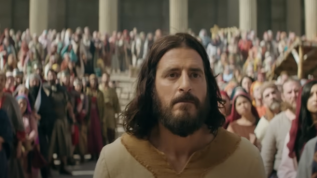VATICAN CITY (AP) - A white marble sarcophagus believed to be the final resting place of the Apostle Paul has been unearthed from beneath the altar of Rome's second-largest basilica after centuries hidden from view, but those curious about its contents will have to wait still longer.
Vatican experts, announcing Monday that the coffin had been unearthed, said they hoped to be able to examine it more closely and maybe even look inside.
But Giorgio Filippi, a Vatican archaeologist, said researchers' first concern was to free it from centuries of plaster and debris in the hope of finding other clues on the sarcophagus itself.
"Right now we can treat it as a symbol, regardless of its contents," Filippi said.
According to tradition, the Apostle Paul, also known as the apostle of the Gentiles, was beheaded in Rome in the 1st century during the persecution of early Christians by Roman emperors. Popular belief holds that bone fragments from his head are in another Rome basilica, St. John Lateran, with his other remains inside the sarcophagus.
The 8-foot-long coffin, which dates from at least A.D. 390 and was buried under the main altar of St. Paul's Outside the Walls Basilica, has been the subject of an extended excavation that began in 2002 and ended last month.
"These excavations give us the full certainty and knowledge that the sarcophagus is St. Paul's tomb, whether it contains his remains or not," said Cardinal Andrea Cordero Lanza di Montezemolo, head of the basilica.
The cardinal said X-rays were unlikely to penetrate the thick marble, making it necessary to open the tomb to find out what is inside. "It has never been opened or explored," he said.
Filippi said the decision to unearth the sarcophagus was made after pilgrims who came to Rome during the Roman Catholic Church's 2000 Jubilee year expressed disappointment at finding that the saint's tomb — buried under layers of plaster and further hidden by an iron grate — could not be visited or touched.
The top of the coffin has small openings — subsequently covered with mortar — because in ancient times Christians would insert offerings or try to touch the remains.
Work in the small area under the altar, to clear the debris and insert a transparent glass floor for better viewing, unearthed new evidence of the authenticity of the sarcophagus, said Filippi, who headed the project.
"Our purpose was not to find out what was inside, but to confirm that it was the original sarcophagus," Filippi said.
The basilica stands at the site of two 4th-century churches — including one destroyed by a fire in 1823 that had left the tomb visible, first above ground and later in a crypt. After the fire, the crypt was filled with earth and covered by a new altar. A slab of cracked marble with the words "Paul apostle martyr" in Latin was also found embedded in the floor above the tomb.
"We were always certain that the tomb had to be there, beneath the papal altar," Filippi said.
Paul, along with Peter, are the two main figures known for spreading the Christian faith after the death of Christ.
Copyright © 2006 The Associated Press. All rights reserved. The information contained in the AP News report may not be published, broadcast, rewritten or redistributed without the prior written authority of The Associated Press.







